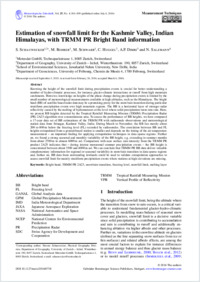Estimation of snowfall limit for the Kashmir Valley, Indian Himalayas, with TRMM PR Bright Band information
- Schauwecker, S. Meteodat GmbH, Zurich, Switzerland - Department of Geography, University of Zurich – Irchel, Switzerland
- Rohrer, M. Meteodat GmbH, Zurich, Switzerland
- Schwarb, M. Meteodat GmbH, Zurich, Switzerland
- Huggel,, C. Department of Geography, University of Zurich – Irchel, Switzerland
- Dimri, A.P. School of Environmental Sciences, Jawaharlal Nehru University, New Delhi, India
- Salzmann, Nadine Department of Geosciences, University of Fribourg, Switzerland
-
06.09.2016
Published in:
- Meteorologische Zeitschrift. - 2016, p. 501–509
English
Knowing the height of the snowfall limit during precipitation events is crucial for better understanding a number of hydro-climatic processes, for instance glacier-climate interactions or runoff from high mountain catchments. However, knowledge on heights of the phase change during precipitation events is limited by the small number of meteorological measurements available at high altitudes, such as the Himalayas. The bright band (BB) of satellite based radar data may be a promising proxy for the snow/rain transition during particular stratiform precipitation events over high mountain regions. The BB is a horizontal layer of stronger radar reflectivity caused by the melting of hydrometeors at the level where solid precipitation turns into rain. Here, we present BB heights detected by the Tropical Rainfall Measuring Mission (TRMM) Precipitation Radar (PR) 2A23 algorithm over a mountainous area. To assess the performance of BB heights, we have compared a 17‑year data set of BB estimations of the TRMM PR with radiosonde observations and meteorological station data from Srinagar, Kashmir Valley, India. During March to November, the BB lies mostly about 200 to 800 m below the freezing level (FL) recorded by radiosondes. The correlation between BB and FL heights extrapolated from a ground-based station is smaller and depends on the timing of the air temperature measurement – an important finding for applying extrapolation techniques in data sparse regions. Further on, we found a strong seasonal and monthly variability of the BB height, e.g. extending in summer months from about 2700 m to almost 6000 m asl. Comparison with near surface rain intensity from the TRMM PR product 2A25 indicates that – during intense monsoonal summer precipitation events – the BB height is concentrated between about 3500 and 4000 m asl. We can conclude that TRMM PR BB data deliver valuable complementary information for regional or seasonal variability in snow/rain transition in data sparse regions and, further on, BB data from surrounding lowlands could be used to validate extrapolation approaches to assess snowfall limit for mainly stratiform precipitation events where stations at high elevations are missing.
- Faculty
- Faculté des sciences et de médecine
- Department
- Département de Géosciences
- Language
-
- English
- Classification
- Meteorology, climatology
- License
-
License undefined
- Identifiers
-
- RERO DOC 278594
- DOI 10.1127/metz/2016/0738
- Persistent URL
- https://folia.unifr.ch/unifr/documents/305334
Statistics
Document views: 145
File downloads:
- pdf: 202
